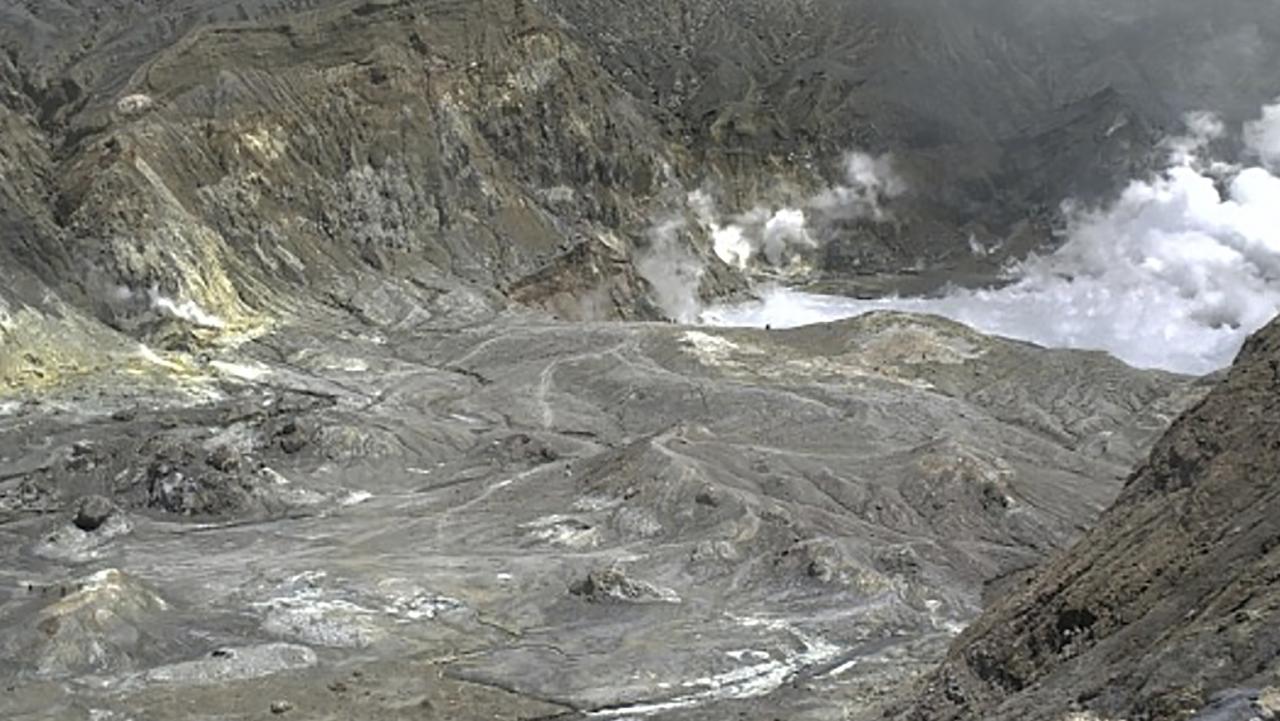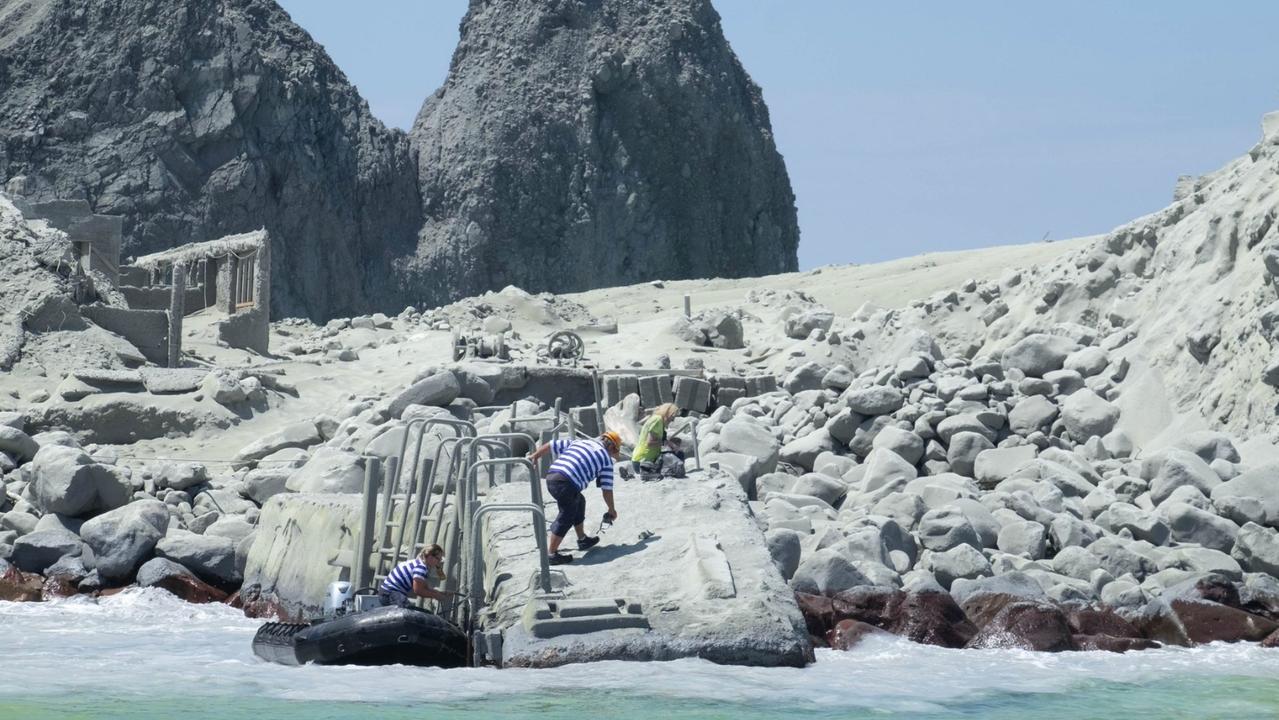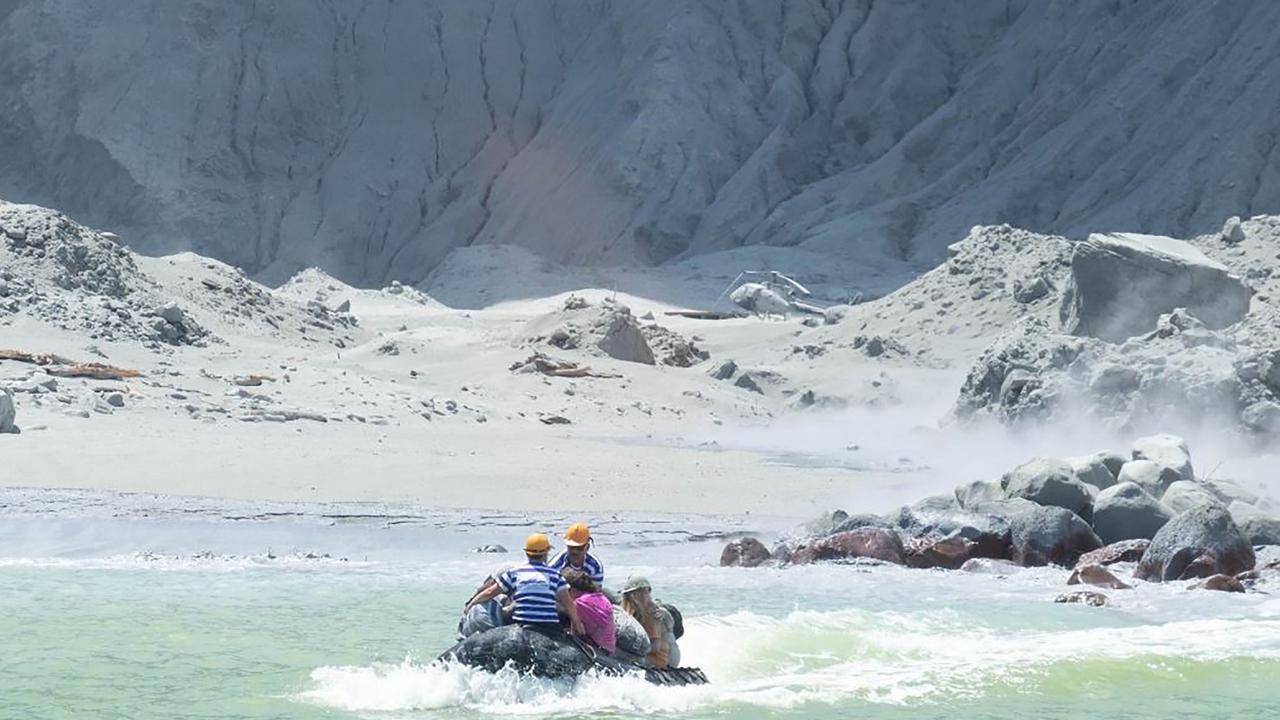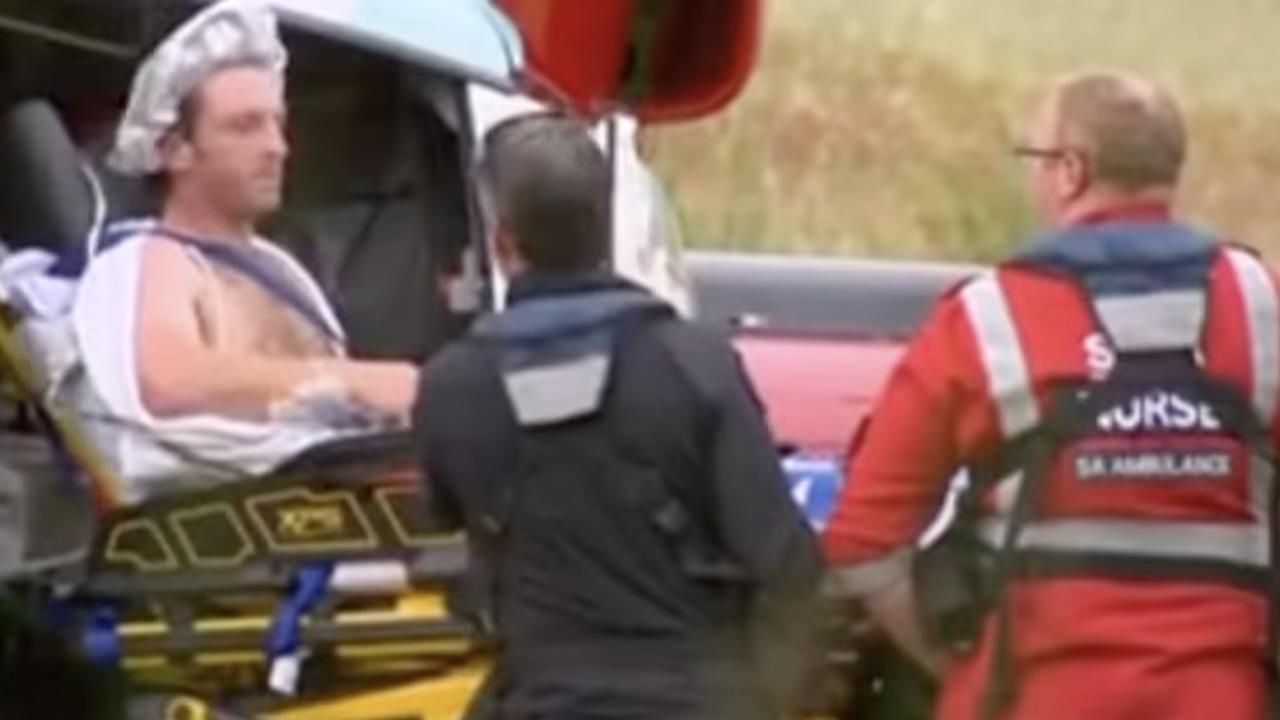How the White Island eruption unfolded
In the final moments before New Zealand’s White Island volcano erupted, camera footage from inside its crater picked up a tragic sight.
A grim image captured seconds before New Zealand’s White Island volcano erupted shows a group of tourists walking inside the crater, seemingly unaware of the imminent danger.
The image is a disturbing reminder of just how sudden the deadly eruption was – and how unprepared the people in its vicinity were.
An agency called GeoNet is responsible for monitoring geological hazards in New Zealand and providing information to the public.
It constantly observes White Island with webcams, seismometers and UV spectrometers. One of those webcams, positioned at the rim of the crater, picked up the group of tourists.
At 2.10pm local time, the group – visible only as specks, due to the massive scale of the volcano around them – could be seen travelling along a trail inside the crater, with plumes of white smoke rising nearby.
One minute later, the volcano erupted.
Subsequent images, from a different webcam on the crater floor, are completely black.
“We are aware that people were on the island immediately before the eruption and we express our concern for their safety,” duty volcanologist Geoff Kilgour said.
“Ash has covered the main crater floor, as seen in our webcam images.”
RELATED: All the latest news on the disaster
RELATED: Australians missing and feared dead


RELATED: Horrified witnesses describe eruption
RELATED: Deadly mix of factors inside volcano
GeoNet has now stopped posting the images from those cameras online.
Five people are confirmed to have died in the eruption, and 11 Australian tourists are still unaccounted for. Aerial reconnaissance of the island this morning found “no signs of life”. Search operations are continuing.
Questions are now being asked about the lead-up to the disaster, and whether tourists should have been allowed on the island at all.
This is how it all unfolded.
SEPTEMBER 26
Almost three months ago, GeoNet reported “small, geyser-like explosions” of mud and steam were happening inside the crater.
The cause was simple enough to explain. The crater lake level had risen, covering some of the active vents on the crater floor with water.
“Normally the gas and steam would vent directly to the atmosphere, now it’s through the water in the vents, and is visible as the geyser-like activity,” volcanologist Steve Sherburn said at the time.
None of this was particularly unusual, and it was not considered cause for concern.
“They do not pose any hazard to visitors to the island and are not a sign of increasing volcanic activity,” he said of the geyser-like explosions.
OCTOBER 30
A month later, the signs were gradually becoming more troubling.
While the Volcanic Alert Level remained at one (out of five), GeoNet reported “an increase in activity” and “a level of uncertainty about what this means”.
There had been a notable change in the volcano’s sulfur dioxide output and its level of volcanic tremor, with both factors at their highest mark since 2016 – when White Island last erupted.
Sulphur dioxide is produced by magma beneath the surface of the earth. Its increase suggested more gas was passing through the volcano from those depths.
But those sorts of fluctuations are common in volcanoes, and could conceivably be caused by all sorts of things. The agency said there was “slight uncertainty” about the exact meaning of its data.
“While the pattern of signals shows similarities with the 2011-2016 period and could suggest that White Island may be entering a period where eruptive activity is more likely than normal, recent observations can also be explained by the increased gas flux,” said GeoNet volcanologist Yannik Behr.
NOVEMBER 18
In mid-November, GeoNet raised the Volcanic Alert Level for White Island to level two, saying the degree of volcanic tremor had increased from weak to moderate strength.
“Volcanic unrest continues and some monitored parameters show further increases in activity. Hazards on the island are now greater than during the past few weeks,” said volcanologist Michael Rosenberg.
He stressed that eruptions of steam, gas, mud or rocks could occur “with little or no warning”.
NOVEMBER 24
A week later, a magnitude 5.9 earthquake shook the Bay of Plenty, where White Island is located.
The earthquake’s epicentre was about 50 kilometres off the coast of New Zealand, and 115 kilometres deep.
It caused “no change” in White Island’s activity, but authorities warned “moderate volcanic unrest” was continuing.
DECEMBER 3
A week ago, GeoNet reported “substantial” gas, steam and mud bursts had been observed at the back of White Island’s crater lake, and were happening more frequently than before.
“This fountaining is regularly throwing mud and debris 20-30 metres into the air,” said volcanologist Brad Scott.
“While the activity is contained to the far side of the lake, the current level of activity does not pose a direct hazard to visitors.”
DECEMBER 9
At 2.11pm local time, the volcano erupted, with two explosions in quick succession spewing a column of ash 3600 metres into the air.
Authorities estimate 47 people were on or around White Island at the time. Due to the webcam image, we know about a dozen of them were unfortunate enough to be inside the crater itself.
Later it emerged the bulk of the people involved – up to 38 of them – were from the cruise ship Ovation of the Seas, which departed Sydney earlier this month.
“We can confirm that a number of our guests were touring the island today,” the ship’s company, Royal Caribbean, said.
“We will offer all possible assistance to our guests and local authorities. Please keep all those affected in your prayers.”
In the minutes immediately after the eruption, White Island Tour operators rescued as many people as they could, evacuating them by boat.
Twenty-three people got off the island. The majority of them had suffered burns.


Official rescue operations were launched immediately. St John Ambulance dispatched seven helicopters to help, Whakatane hospital was turned into an emergency operation centre, and New Zealand Police advised people to avoid a large area along the coast.
But they were hampered by the treacherous conditions, which prevented them from setting foot on the island itself and made it difficult to determine how many victims were stranded.
“Some of these people have been transported to shore, however there is a number still remaining on the island who are currently unaccounted for,” Police Deputy Commissioner John Tims said as the afternoon unfolded.
“At this stage, it is too dangerous for police and rescue services to go to the island.
“The island is currently covered in ash and volcanic material. We are taking expert advice with regards to the safety of any rescue attempt.”
Prime Minister Scott Morrison confirmed a number of Australians had been “caught up” in the disaster.
“A terrible tragedy is unfolding,” Mr Morrison said.
“Australians have been caught up in this terrible event and we are working to determine their wellbeing.”
As afternoon turned into evening, and rescuers were still unable to access White Island, the official death toll rose to five.
“The physical environment is unsafe for us to return,” said Mr Tims.
He said “at least a double digit number of people” remained on the island, but emergency services would not be in a position to reach it until at least the next day.
DECEMBER 10
The morning dawned with more terrible news. A number of aerial reconnaissance flights over the island had found “no signs of life” at “any point”.
“Based on the information we have, we do not believe there are any survivors on the island,” police announced.
“Police believe that anyone who could have been taken from the island alive was rescued at the time of the evacuation.
“We’re working urgently to confirm the exact number of those who have died, further to the five confirmed deceased already.”
Meanwhile, Mr Morrison confirmed 24 Australians had been visiting the island, and 11 of them were still missing. He said he feared there was “worse news to come”.
“Of the 24 ones, we have been able to ascertain overnight and this morning that 13 of those Australians are hospitalised across multiple hospitals in New Zealand,” the Prime Minister said.
“There are 11 Australians that are still unaccounted for, and that we fear of the five deceased persons, that three of those, up to three are Australians, but that is not yet confirmed.”
Shortly before midday, GeoNet released a new assessment of the conditions, estimating there was a 50 per cent chance of another eruption occurring within the next 24 hours.
“Since the eruption, seismic activity has dropped to low levels and there has been no further eruptive activity. However we are still observing localised steam and mud jetting from the active vent area,” said Geoff Kilgour.
“Over the next 24 hours we estimate an equal likelihood of either no eruption or a smaller/similar sized eruption that would impact the main crater floor. There is a high level of uncertainty.
“The least likely scenario is a larger eruption.”
The Volcanic Alert Level stayed at level three.
New Zealand Prime Minister Jacinda Ardern remained focused on the rescue effort. But speaking to the media on Tuesday afternoon, Ms Ardern indicated there were questions that would need to be answered when the crisis ends.
“We know too there will be bigger questions in relation to this event,” she said.
“These questions must be asked and must be answered.”




